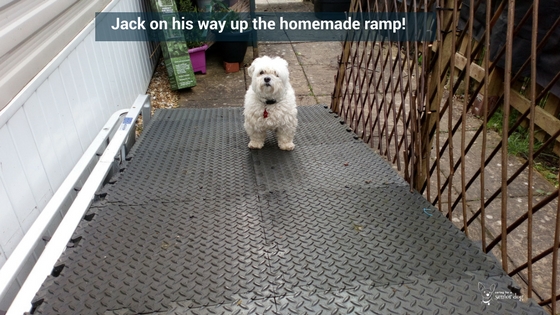
I’ve piqued your curiosity haven’t I? Excellent!
As someone who lives with senior dogs, and dogs so neglected they have no idea how to use stairs, I love these products and would never be without one or both. I try and take pictures as much as possible, but unfortunately  have none to show you of them being used in my house.
have none to show you of them being used in my house.
So what are the 2 things you must know?
- What a difference they will make in the life of your pet
- How much easier things will be for you.
How you ask? Keep reading as we talk about the benefits of both.
Benefits of ramps and stairs for your dog
- Help arthritic dogs get on and off the couch or bed, and in and out of the car
- Senior dogs who are slowing down and could use that extra bit of help
- Stops your pet from putting undue pressure on joints when jumping, reducing wear and tear, preventing injury now to hopefully avoid problems later
- Dogs too small or too young to jump can still have access to the spots they like
- Perfect for pets recovering from an injury or surgery who have to take it easy
- Makes it easier to get into a bathtub at the groomers, or at home
- Your dog no longer has to wait for help from you, and avoids injury if you aren’t around and decides to jump on his own
- A ramp is perfect for a dog who doesn’t know how to use stairs, or has trouble using them
Benefits for you
- You no longer have to lift your dog in and out of the car, or on and off of the couch
- You have a giant breed that is just too big to pick up
- Back or joint problems may make it difficult for you to lift even a small dog, and now you won’t have to
- You don’t have to constantly monitor your dog, to make sure he’s not going to hurt himself by jumping when he shouldn’t
- Even if you have nothing preventing you from picking your dog up all the time, why should you have to?
My experience using a ramp
A few years ago we rescued Saffy, a puppy mill dog who had been kept in a chicken coop for 8 years, breeding. It became apparent quite quickly she had never seen stairs, or had any idea how to use them. Rather than try and put her paws on each step, she would literally just fall down them. Getting back up was no better.
You may be asking yourself why I didn’t just pick her up and carry her. She had been so traumatised by her ordeal, being picked up freaked her out, so I certainly did not want to scare her more than she already was.
Naturally she ended up hurting her leg, not seriously thank goodness. It did, however, cause me to increase the frequency of the pleas to my husband to build a ramp for her. Because of the position of the door, no store bought ramp would fit, so it had to be custom built, and it was perfect. The incline was very gradual and she had no trouble walking up and down.
We did use a folding store bought one for the bedroom, so she could get onto the bed. That incline was a bit steeper, again because of the amount of room but it worked perfectly.
Those ramps made a huge difference in Saffy’s life, and ours.
Which is better – a dog ramp or dog stairs?
The question isn’t so much which one is better, but rather which one is better for your particular needs.
- The main advantage of stairs over a ramp is they take up less space. They can go right up against a bed in a small space where a ramp cannot.
- Stairs may not be as stable as a ramp
- Depending on a dog’s mobility issues, stairs may be more difficult to use
- A ramp, particularly one with a very gradual incline, is likely easier for an arthritic dog to manage
Features to think about when choosing
Once you’ve decided whether you want stairs or a ramp, these features will help you narrow down the options, and ultimately help you choose the right one. Most of the features listed will apply to both.
- Do you need something for indoor use, outdoors, or both?
- What will you be using it for – getting on and off the couch? In and out of the car? On and off a boat?
- Height the stairs or ramp has to reach
- Maximum weight it will support
- Ease of assembly
- Can it be folded and stored
- Portability – how easy is it to carry
- Stability when set up – something that wobbles can be dangerous for your pet to use
- Non slip surface – having your pet slip, especially if used outdoors in wet weather, or with muddy paws, can cause injury
- How steep the slope of the ramp is
- Width
- Number of steps
- Height and depth of each step
- Type of material
- Style
- Budget
Dog Ramps
Dog Stairs
2 Things You Must Know About dog ramps and dog stairs – conclusion
Anything that makes a dog’s life easier and more comfortable makes me very happy. Knowing how many options there are to help senior dogs who have mobility issues makes me even happier.
Have you decided on a ramp or stairs? What made you choose one over the other? I’d love to hear how it has helped make things easier for your dog…and you. Share your story in the comments section, and feel free to send pictures of your happy pup.
I would like to invite you to join Senior Dog Care Club, a new Facebook group for senior dog parents. There you will find lots of helpful tips and advice, a place to ask questions and share experiences. I look forward to welcoming you.


 Dogs Die in Hot Cars: Don’t Let Yours Be Next
Dogs Die in Hot Cars: Don’t Let Yours Be Next
My pet Lucy has been using the ramp for 6 years. She is 8 year old now. She just started to refuse to go up the ramp. Two days ago. She did get out of the house and was in the back yard after that she refuses to go up ramp. She goes down the ramp but won’t go up the ramp anymore. I try to us treats and she refuses to go up the ramp into the house. What could be wrong. Is she afraid to go up. Or does she have a medical condition. Is it arthritis, a bug bite .
Any suggestions would help me. I will take her to the vet. For a check out.
Hi and thanks for writing in about Lucy. Dog ramps are fantastic aren’t they!! When a dog suddenly is afraid or reluctant to do something he’s always done, it’s usually because something frightened him at the time. Of course it’s possible your dog may have arthritis, and I always recommend a vet check when there is a change in behaviour, but as her unwillingness to walk up the ramp happened when she got out of the house, something must have spooked her. When you found she had gotten out of the house were you perhaps a bit cross with her? Perhaps you raised your voice out of concern, but she got scared by the change in tone. If that happened while she was going back into the house, that could absolutely account for her not going up, but still happily walking down.
She now has some negative associations with walking up the ramp, so trying desensitization techniques can help.
You say you’ve used treats but I don’t know what kind or how often or even how you’ve used them, so here is what I recommend you try.
Use really delicious treats she loves but never or rarely gets. Boiled chicken, hot dogs, turkey, a bit of cheese… Start from scratch as though you’re training her how to walk up a ramp. Is there a point at which she won’t get closer to the ramp? If there is start before you reach that point, get her to sit and give her a treat. Take a tiny step closer, then give her another treat. Take this very slowly because if you advance too quickly she may get scared and you’ll get set back.
You’ll want to have her get closer and closer to the ramp, using those delicious treats.
Once she’s at the foot of the ramp and she’s still comfortable you can –
Hold a treat far enough up the ramp that she has to put one paw on it, give her the treat then let her get off, or put the treat at the bottom of the ramp, let her eat it then let her get off. Only when she’s comfortable can you put a second treat higher up, then a third. You’d like to be able to place a trail of treats to the top, without her being nervous.
If at any time she seems hesitant, stop what you’re doing and go back to the point she was okay.
You don’t want to talk and molly coddle her during this training, because that just reinforces her fear. Be sure to take it slowly, do only very short sessions if you have to, even if that means a few seconds at a time, a few times a day.
Let me know if this helps. Good luck with Lucy.
I wanted to add a note here about my Sr. Cat. Going up a ramp is actually more difficult because she has to use the strength in her back legs and hips which seem to bother her more than going down? Doesn’t it make a difference which joints are more compromised.
I know what you mean, that’s why if anyone is considering a ramp I always say the incline should be as gradual as possible. It’s easier to walk up that way, and for pets that have never used it before it seems to make it more inviting.